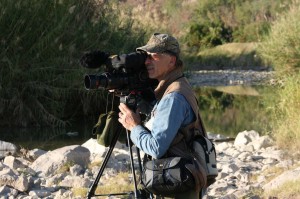
He reported that he relies on his Cine DSLR system from Sachtler, part of Vitec Videocom.
“The unique problem for me is my need to combine sturdiness with mobility. This results in a contradictory, joint need for gravity and mobility in one tripod system – a very tall order,” he explained. “Sachtler has been boosting the capacity of smaller fluid heads while making ever sturdier and lighter tripods.”
“To me, the Cine DSLR system features multiple ways to support the weight of the camera and lens and to balance weight distribution,” he explained. “The multiple levels of counterbalance and the sliding tripod mounting plate are ideal for my kind of work. What is really unique is its ultra-long camera mounting plate, which is calibrated for repeatable precision in balancing the camera and lens at each set up.”
In Mrozek’s line of work, speed of set up and capture is essential. With wildlife, a split-second delay can make all the difference. “I found that the Cine DSLR has enabled me to capture much more interesting bird behavior, for example,” he said. “On a recent trip to the Big Bend region of Texas, I was trying to capture feeding and other behaviors of fleet-footed birds, like road runners and scaled quail. I often had to shoot them from 50-plus meters away due to their wariness. This means shooting at full telephoto with my Canon video lens maxed out at 32X including a 1.6X tele-converter.
“Balancing the camera and lens on the head is absolutely critical for a stable image at high magnification, which is what I’m often working with when shooting wildlife – like coyotes and peccaries at least a football field away.”
Mrozek recently switched his focus from birds to burros, to shoot a documentary on these wild animals in the American Southwest. Capturing these animals included adding or subtracting the 1.6X converter or swapping lenses entirely. “Typically, I rotate between the Canon 20X HD video lens and the Canon EF 100-400mm lens for ultra-telephoto needs,” he explained. “This radically changes the balancing point on camera and lens.
“Without the Cine DSLR’s extra long camera mounting plate, balancing the long 100-400mm lens would be challenging, to say the least.”
Whether it’s birds or burros, Mrozek produces compelling wildlife sequences for shows like CBS Sunday Morning’s Moment of Nature segment, or other wildlife programs such as Profiles in Nature (Discovery/Animal Planet), Marty Stouffer’s Wild America for PBS, plus news and short features for the Weather Channel and CNN. “I can honestly say that Sachtler’s Cine DSLR tripod system has enabled me to maintain mobility and agility while achieving the stability critical for the broadcast quality content these shows expect from their cameramen.”





